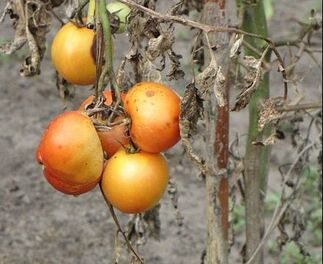Curling tomato leaves should not be ignored. Learn what to do to bring your tomatoes back to good health.

Where we live, extreme temperatures (particularly high heat or cold) and exposure to high winds can cause tomato leaves to curl. Protect your plants from environmental stressors by creating a consistently warm place for them to grow. This can be wall-of-waters, building a small 'pop-up' greenhouse with plastic and stakes, or planting them close to a south-facing wall to minimize wind and take advantage of the heat the wall gives back at night.
Tomatoes that receive inconsistent or improper watering often exhibit leaf curling, especially over-watering, which suffocates the roots and hinders nutrient uptake. Conversely, under-watering causes drought stress which causes the leaves to curl. Keep track of when and how much water you give your tomatoes, and always check the soil before watering by using a soil moisture meter to accurately gauge whether water is necessary.
A lack of essential nutrients such as nitrogen, potassium, or magnesium can cause leaf curling. Note, however, that too much of any nutrient, particularly nitrogen, can also cause the condition. Here is a guide on how and when to fertilize your tomatoes.
A raised bed with a soil depth of minimum 8 inches works best for growing tomatoes and established plants should be watered deeply for 20 to 30 minutes three to four times per week. If you grow tomatoes in a shallower bed, check them daily to catch early signs of dehydration.
Aphids, whiteflies, spider mites, and thrips are all pests that vex tomato plants. These pests feed on the plant's sap and disrupt normal growth. Closely inspect your plants to see if you spot any pests that may be harming your plant(s). Manage pests by using Pyrethrin, a natural product for the control of aphids and caterpillars. Neem oil extract and insecticidal soap are less toxic options for the control of aphids and whiteflies. Horticultural oil is a less toxic option to control spider mites, whiteflies, and aphids.
Viral infections, like tomato yellow leaf, curl virus, and tomato mosaic virus, can result in distorted and curled foliage. Fungal diseases such as Fusarium wilt and early blight can also cause leaf curling symptoms. To prevent disease, only use certified disease-free seeds and plants. Avoid planting in areas that were planted with peppers or tomatoes during the previous year. Use drip or furrow irrigation - no overhead watering. Remove and dispose of all diseased plants that appear to be diseased, or the issue will migrate to other tomatoes in the same space.
Curly Top Virus - when the leaves of your tomatoes, squashes, watermelons or other garden crops thicken and curl, plant growth is stunted, and they eventually die, the cause might be curly top virus (CTV). The disease is also known as beet curly top virus named after the beet leafhopper, the insect that transmits the virus. Learn more about this here.
Exposure to herbicides or weed killers, either through drift from nearby applications or accidental overspray, can cause leaf curling and other abnormalities in tomato plants. Use these products only on very calm days (early morning is best) to ensure drift doesn't occur.
Some tomato varieties may naturally exhibit leaf curling traits. This is often seen in heirloom or wild-type tomato varieties.